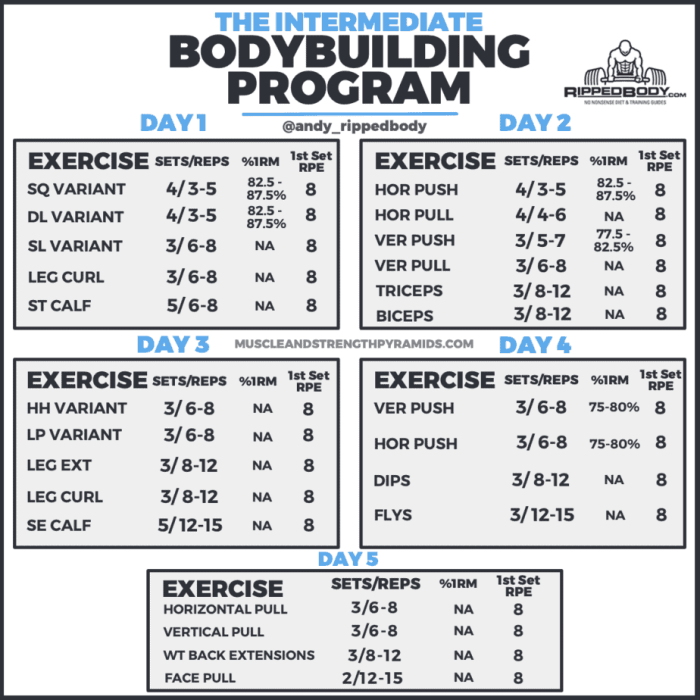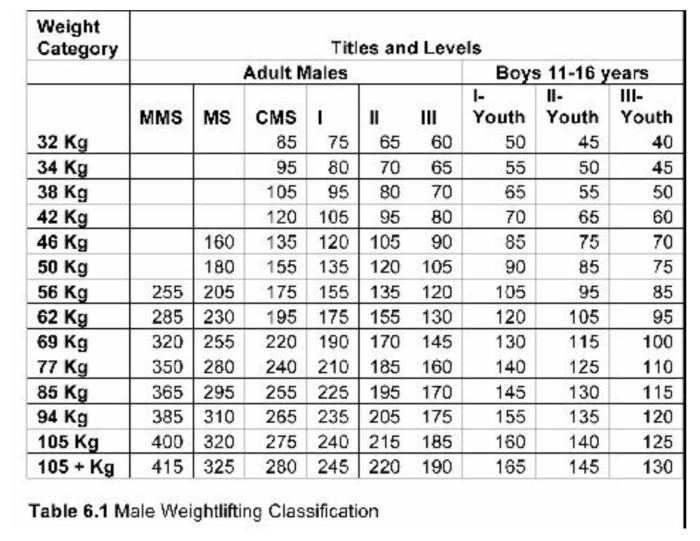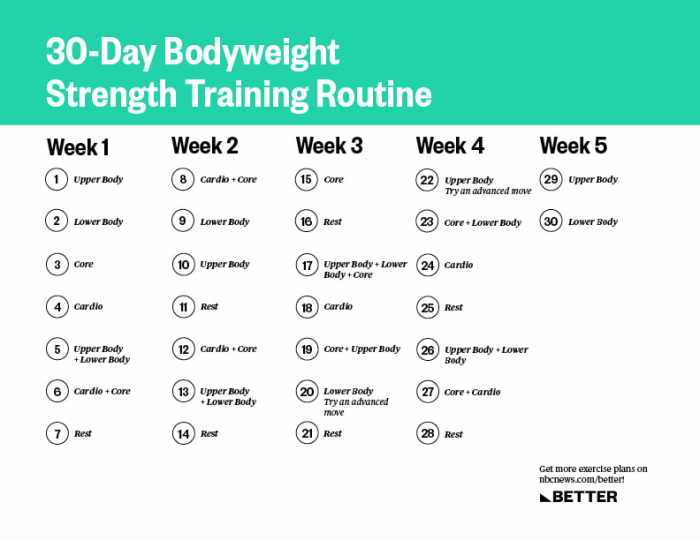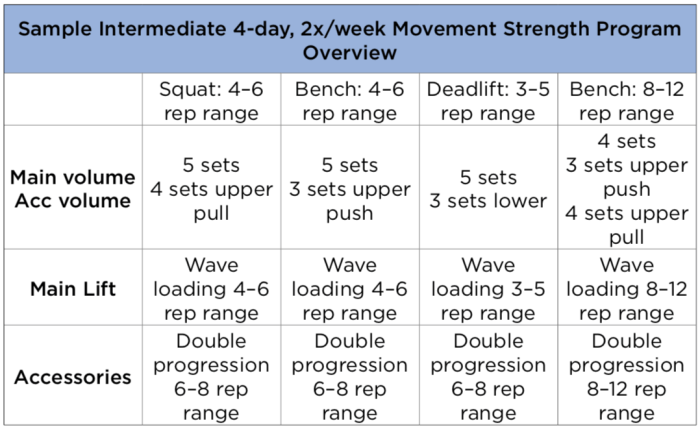Embark on a journey to build strength and improve your overall fitness with our comprehensive weightlifting strength program. Whether you’re a seasoned lifter or just starting out, this guide will provide you with the essential knowledge and tools to achieve your strength-building goals.
Our program covers every aspect of weightlifting, from exercise selection and training variables to recovery and nutrition. With a focus on proper form and technique, we’ll help you minimize the risk of injury and maximize your results.
Program Design: Weightlifting Strength Program
Designing a weightlifting strength program requires understanding the principles of exercise science and tailoring it to individual needs. Setting clear goals, such as increasing maximum strength or muscular endurance, is crucial for creating a program that is effective and sustainable.
Periodization and progression are essential for long-term strength development. Periodization involves dividing the program into distinct phases, each with specific goals and training parameters. Progression refers to gradually increasing the intensity and volume of training over time, which is necessary to continually challenge the body and promote adaptation.
Sample Periodization Plan
- Preparation Phase:Focus on building a base of strength and fitness with higher volume and lower intensity.
- Strength Phase:Prioritize maximal strength development with lower volume and higher intensity.
- Transition Phase:Gradually reduce intensity and increase volume to prepare for the next strength phase.
Exercise Selection
Selecting the right exercises is crucial for building strength effectively. Consider your goals, muscle groups you want to target, and your fitness level when choosing exercises. Here’s a comprehensive list of exercises categorized by muscle groups and movement patterns, along with their benefits and drawbacks:
Upper Body Exercises
Push Exercises
- Barbell Bench Press:Compound exercise targeting the chest, shoulders, and triceps. It’s a great mass builder, but requires good technique to avoid shoulder injuries.
- Incline Dumbbell Press:Similar to bench press, but with an incline, it emphasizes the upper chest.
- Overhead Press:Targets the shoulders, triceps, and upper chest. It improves shoulder stability and mobility.
Pull Exercises
- Barbell Row:Compound exercise that works the back, biceps, and forearms. It’s a great back builder, but requires proper form to avoid lower back strain.
- Pull-Ups:Bodyweight exercise that targets the back, biceps, and forearms. It’s a challenging exercise that can be modified for different fitness levels.
- Lat Pulldown:Machine-based exercise that isolates the back muscles. It’s a good option for beginners or those with shoulder issues.
Lower Body Exercises
Quadriceps Exercises
- Barbell Back Squat:Compound exercise that targets the quads, glutes, and hamstrings. It’s a foundational exercise for building lower body strength.
- Leg Press:Machine-based exercise that isolates the quads. It’s a good option for those with knee issues or as a supplemental exercise to squats.
- Bulgarian Split Squat:Single-leg exercise that targets the quads and glutes. It improves balance and stability.
Hamstring Exercises
- Romanian Deadlift:Compound exercise that targets the hamstrings, glutes, and lower back. It’s a great hamstring builder, but requires good technique to avoid injuries.
- Hamstring Curl:Machine-based exercise that isolates the hamstrings. It’s a good option for beginners or as a supplemental exercise to deadlifts.
- Glute Bridge:Bodyweight exercise that targets the hamstrings and glutes. It’s a good exercise for improving hip mobility.
Calf Exercises
- Standing Calf Raise:Bodyweight exercise that targets the calves. It’s a simple but effective exercise for improving calf strength and size.
- Seated Calf Raise:Machine-based exercise that isolates the calves. It’s a good option for those with ankle issues or as a supplemental exercise to standing calf raises.
Set and Rep Schemes
In strength training, sets and repetitions (reps) play a crucial role in determining the intensity and effectiveness of your workouts. Sets refer to the number of times you perform a particular exercise consecutively, while reps refer to the number of times you complete the movement within each set.
The combination of sets and reps, known as a rep scheme, significantly influences the adaptations you elicit from your training. Understanding the differences between low, moderate, and high rep ranges is essential for tailoring your workouts to your specific strength goals.
Low Rep Range
Low rep ranges, typically between 1-5 repetitions per set, are ideal for building maximal strength. These heavy lifts require near-maximal effort and target the recruitment of high-threshold motor units, which are responsible for producing the greatest force output. Low rep training promotes neurological adaptations, including improved motor unit recruitment and synchronization, leading to increased strength levels.
Moderate Rep Range
Moderate rep ranges, typically between 6-12 repetitions per set, are effective for developing both strength and hypertrophy (muscle growth). These sets allow for a balance between intensity and volume, stimulating both neural and muscular adaptations. Moderate rep training promotes increased muscle fiber recruitment, improved muscle protein synthesis, and enhanced metabolic adaptations, contributing to overall strength gains and muscle development.
High Rep Range
High rep ranges, typically between 12-20 repetitions per set, are primarily used for muscular endurance and hypertrophy. These sets involve relatively lighter weights and focus on maintaining constant tension on the target muscle group. High rep training promotes increased capillary density, improved mitochondrial function, and enhanced muscular endurance, making it suitable for activities requiring sustained muscle contractions.
It’s important to note that the optimal set and rep schemes vary depending on your individual goals, training experience, and recovery capacity. A personalized approach, guided by a qualified professional, is recommended to maximize your strength training outcomes.
– Discuss the concept of training intensity and its impact on strength gains.

Training intensity is a crucial factor in strength development. It refers to the amount of effort exerted during a workout, which can be measured and adjusted through various methods. The appropriate intensity level depends on individual fitness goals, training experience, and recovery capacity.
Higher intensity workouts, typically involving heavier weights or more repetitions, lead to greater muscle fiber activation and recruitment, resulting in increased strength gains. However, excessive intensity can also increase the risk of injuries and hinder recovery. Conversely, lower intensity workouts may not provide sufficient stimulus for strength development.
Measuring and Adjusting Intensity
- Load:The amount of weight lifted, expressed in kilograms or pounds.
- Volume:The total amount of work performed, calculated as the number of sets multiplied by the number of repetitions.
- Effort:The perceived exertion during a set, typically measured on a scale of 1 to 10.
- Rest periods:The time between sets or exercises, which influences recovery and subsequent performance.
Progressive Overload
Progressive overload is a fundamental principle of strength training. It involves gradually increasing the intensity or volume of workouts over time to continuously challenge the muscles and promote adaptation. This process allows for continuous strength gains and prevents plateaus.
Intensity Management Strategies
Intensity management strategies vary based on individual goals and fitness levels. Some common approaches include:
- Linear progression:Gradually increasing load or volume in a structured manner.
- Undulating periodization:Alternating periods of high and low intensity to optimize recovery and progress.
- Auto-regulation:Adjusting intensity based on perceived effort and recovery status.
Recovery and Nutrition

Proper recovery and nutrition are crucial for maximizing strength gains. This includes optimal rest periods, adequate nutrient intake, and effective stress management.
Rest and Recovery
Rest allows muscles to repair and rebuild, promoting strength development. Aim for 1-2 minutes of rest between sets and 2-5 minutes between exercises. Allow 24-48 hours of rest for each muscle group before training it again.
Nutrition
Protein intake is essential for muscle growth and repair. Aim for 1.6-2.2 grams of protein per kilogram of body weight per day. Carbohydrates provide energy for workouts, while fats support hormone production and muscle recovery. Consume 5-10 grams of carbohydrates per kilogram of body weight per day and 1-1.5 grams of fat per kilogram of body weight per day.
Sleep and Stress Management
Sleep deprivation impairs recovery and strength gains. Aim for 7-9 hours of quality sleep per night. Reduce stress through activities like yoga, meditation, or spending time in nature. Effective stress management during training involves maintaining proper form and avoiding excessive weight.
Warm-Up and Cool-Down
A proper warm-up prepares the body for the demands of weightlifting, reducing the risk of injury and improving performance. It gradually increases body temperature, heart rate, and blood flow to the muscles, making them more responsive to exercise.
Warm-Up Routine
A sample warm-up routine for strength training:
- Dynamic stretching:5-10 minutes of movements that mimic the exercises to be performed, such as arm circles, leg swings, and torso twists.
- Light cardio:5-10 minutes of light cardio, such as jogging, cycling, or rowing, to further increase heart rate and blood flow.
- Activation exercises:2-3 sets of 10-15 repetitions of exercises that target the primary muscle groups involved in the workout, such as bodyweight squats, push-ups, and rows.
The intensity of the warm-up should be gradually increased as you approach your working sets.
Cool-Down
Cooling down after a workout helps the body recover by reducing muscle soreness, promoting flexibility, and preventing dizziness. It gradually decreases heart rate, blood pressure, and body temperature.
- Static stretching:5-10 minutes of holding each stretch for 20-30 seconds, targeting the major muscle groups worked during the workout.
- Foam rolling:5-10 minutes of using a foam roller to massage and release tension in the muscles.
- Light cardio:5-10 minutes of light cardio, such as walking or swimming, to gradually decrease heart rate.
Summary Table
| Warm-Up | Cool-Down ||—|—|| Purpose:Prepares the body for exercise | Purpose:Helps the body recover after exercise || Benefits:Reduces risk of injury, improves performance | Benefits:Reduces muscle soreness, promotes flexibility || Duration:5-10 minutes | Duration:5-10 minutes || Exercises:Dynamic stretching, light cardio, activation exercises | Exercises:Static stretching, foam rolling, light cardio |
Common Mistakes to Avoid
- Skipping the warm-up or cool-down.
- Performing the warm-up too intensely.
- Stretching too aggressively during the warm-up.
- Not holding stretches long enough during the cool-down.
- Ignoring foam rolling or light cardio in the cool-down.
Adjusting Warm-Up and Cool-Down
Adjust the warm-up and cool-down routines based on your fitness level and exercise goals. Beginners may need a shorter warm-up and cool-down, while advanced lifters may need a longer and more intense warm-up. The intensity and duration of the warm-up should also be adjusted based on the exercises being performed and the weight being lifted.
Tracking and Evaluation

Tracking your progress is essential for any weightlifting program. It allows you to monitor your improvements, identify areas for improvement, and make adjustments as needed.
Methods for Tracking
There are several methods for tracking your progress, including:
- Weight lifted: Record the amount of weight you lift in each exercise.
- Sets and reps completed: Track the number of sets and reps you complete for each exercise.
- Body measurements: Take measurements of your body circumferences (e.g., chest, waist, thighs) to assess changes in body composition.
Evaluating Progress
Once you have been tracking your progress for a period of time, you can evaluate it to see how you are doing. Look for consistent improvements in the weight you are lifting, the number of sets and reps you are completing, or your body measurements.
If you are not seeing progress, you may need to make adjustments to your program.
Variations for Different Goals

A weightlifting program can be tailored to specific goals, such as powerlifting, bodybuilding, or athletic performance. Each goal requires different training protocols and exercise variations to achieve optimal results.
Powerlifting
Powerlifting focuses on maximal strength development. Training protocols involve low repetitions (1-5) with heavy weights. Exercises include squats, bench press, and deadlifts.
Bodybuilding
Bodybuilding aims to build muscle mass and enhance aesthetics. Training protocols involve higher repetitions (8-12) with moderate weights. Exercises include isolation movements that target specific muscle groups, such as bicep curls and tricep extensions.
Athletic Performance
Weightlifting for athletic performance enhances strength, power, and explosiveness. Training protocols vary depending on the sport. Exercises include plyometrics, Olympic lifts, and dynamic movements that mimic sport-specific actions.
Proper nutrition and recovery are crucial for achieving specific goals. Powerlifters require a high-calorie diet to support heavy lifting. Bodybuilders need a balanced diet with sufficient protein to build muscle. Athletes require a diet tailored to their sport’s demands.
Here are sample workout plans tailored to different goals:
| Goal | Sample Workout Plan |
|---|---|
| Powerlifting |
|
| Bodybuilding |
|
| Athletic Performance |
|
Advanced Techniques

Advanced training techniques are designed to enhance strength gains and muscle development for experienced lifters. These techniques involve variations in set and rep schemes, exercise selection, and training intensity to maximize results.
Drop Sets
Drop sets involve performing multiple sets of an exercise without rest, gradually reducing the weight or resistance after each set. This technique helps exhaust the muscles and recruit more muscle fibers.
Supersets
Supersets involve performing two or more exercises back-to-back without rest. This technique targets different muscle groups or muscle fibers, increasing training efficiency and muscle stimulation.
Plyometrics
Plyometrics involves exercises that combine strength and speed, such as jumps and bounds. These exercises enhance power output and explosiveness.
Isometrics
Isometrics involve holding a static position against resistance for an extended period. This technique helps improve muscular endurance and strength in specific joint angles.
Rest-Pause Training, Weightlifting strength program
Rest-pause training involves performing a set of an exercise to failure, then resting for a short period (usually 15-30 seconds) before continuing with another set to failure. This technique helps overcome plateaus and increase muscle mass.
Eccentric Training
Eccentric training focuses on the lowering or negative phase of an exercise. This technique helps increase muscle damage and soreness, potentially leading to greater muscle growth.
Special Considerations
Weightlifting is not a one-size-fits-all approach. Different populations have unique needs and considerations that must be taken into account when designing a strength program. This section will discuss weightlifting considerations for beginners, older adults, and individuals with injuries.
Beginners
- Start with a light weight and gradually increase the weight as you get stronger.
- Focus on proper form before adding weight.
- Listen to your body and rest when you need to.
- Don’t be afraid to ask for help from a qualified personal trainer.
Older Adults
- Start with a light weight and gradually increase the weight as you get stronger.
- Focus on exercises that improve balance and stability.
- Listen to your body and rest when you need to.
- Consult with your doctor before starting a weightlifting program.
Individuals with Injuries
- Start with a light weight and gradually increase the weight as you get stronger.
- Focus on exercises that do not aggravate your injury.
- Listen to your body and rest when you need to.
- Work with a qualified physical therapist to design a safe and effective weightlifting program.
Sample Programs
To help you get started, here’s a table summarizing different weightlifting strength programs, including their goals, exercise selection, and training protocols.
Choose a program that aligns with your experience level and goals. Remember, proper form and safety precautions are crucial. Consult with a qualified professional if you’re unsure.
Sample Weightlifting Strength Programs
| Program | Goals | Exercise Selection | Training Protocol |
|---|---|---|---|
| Beginner Strength Training | Build a foundation of strength | Compound exercises (e.g., squats, deadlifts, bench press) | 3 sets of 8-12 repetitions, 2-3 times per week |
| Intermediate Powerlifting | Increase maximal strength | Powerlifting exercises (e.g., squat, bench press, deadlift) | 4-6 sets of 3-6 repetitions, 1-2 times per week |
| Advanced Bodybuilding | Build muscle mass and definition | Isolation exercises (e.g., bicep curls, tricep extensions, leg extensions) | 3-4 sets of 10-15 repetitions, 4-5 times per week |
Note:Rest periods between sets and exercises vary depending on the program and individual needs.
Illustrations

Visual aids play a crucial role in effective weightlifting instruction. They provide a clear understanding of proper form and technique, minimizing the risk of injuries and maximizing training efficiency. Our comprehensive illustrations showcase key exercises, variations, and advanced techniques.
Each illustration is meticulously crafted to capture the nuances of movement patterns, muscle activation, and joint alignment. They serve as a valuable resource for both beginners seeking to establish a solid foundation and experienced lifters aiming to refine their technique.
Key Exercises
- Barbell Back Squat:Depicts the proper stance, bar placement, and depth for a safe and effective squat.
- Bench Press:Demonstrates the optimal grip width, chest positioning, and bar path for maximizing chest development.
- Deadlift:Illustrates the starting position, hip hinge mechanics, and lockout technique for a powerful and injury-free deadlift.
- Overhead Press:Showcases the correct shoulder positioning, core engagement, and bar trajectory for building strong and stable shoulders.
- Pull-Ups:Depicts various grip variations and proper body mechanics for effective back and arm development.
Exercise Variations
Our illustrations also encompass different exercise variations to cater to individual needs and training goals.
- Front Squat:Highlights the benefits and technique of holding the barbell in front of the body.
- Incline Bench Press:Demonstrates the setup and execution of the incline bench press, targeting the upper chest.
- Romanian Deadlift:Illustrates the unique hip hinge movement pattern of the Romanian deadlift, emphasizing hamstring development.
- Dumbbell Flyes:Showcases the proper form for dumbbell flyes, isolating the chest muscles.
- Chin-Ups:Depicts the variations between chin-ups and pull-ups, targeting different muscle groups.
Advanced Techniques
For experienced lifters seeking to push their limits, our illustrations cover advanced techniques to enhance training intensity and effectiveness.
- Supersets:Demonstrates how to combine two exercises back-to-back, reducing rest time and maximizing muscle fatigue.
- Drop Sets:Illustrates the technique of reducing weight immediately after a set to failure, intensifying muscle recruitment.
- Forced Reps:Depicts the use of a spotter to assist with additional repetitions beyond muscle failure, promoting muscle growth.
- Eccentric Overload:Showcases the technique of emphasizing the eccentric (lowering) phase of an exercise, building muscle mass and strength.
- Isometric Holds:Demonstrates the benefits and execution of holding a static position during an exercise, enhancing muscle endurance.
Frequently Asked Questions (FAQs)
Weightlifting strength programs can raise many questions. Here are some common queries and their respective answers to provide guidance and clarity.
These FAQs cover various aspects of weightlifting strength programs, including program design, exercise selection, nutrition, and recovery. Whether you’re a beginner or an experienced lifter, these questions and answers can help you optimize your training and achieve your strength goals.
Program Design
- How do I design a weightlifting strength program?
Program design should align with your fitness level, goals, and available time. Consider factors like exercise selection, set and rep schemes, rest periods, and progression strategies.
- How often should I train?
Training frequency depends on your experience, recovery ability, and goals. Beginners may start with 2-3 sessions per week, while advanced lifters can train more frequently.
- How long should my workouts be?
Workout duration varies based on training intensity, exercise selection, and rest periods. Aim for 45-90 minutes per session, adjusting as needed.
Exercise Selection
- What exercises should I include in my program?
Exercise selection should target major muscle groups and compound movements. Include exercises like squats, deadlifts, bench press, overhead press, and rows.
- How do I choose the right exercises for my goals?
Identify your specific strength goals and select exercises that effectively target those muscle groups. For example, if you want to improve lower body strength, focus on exercises like squats and leg press.
- How many exercises should I do per workout?
The number of exercises depends on your training level and workout duration. Beginners may start with 5-7 exercises, while advanced lifters can perform 8-12 or more.
Nutrition
- What should I eat to support my strength training?
Consume a balanced diet rich in protein, carbohydrates, and healthy fats. Protein is crucial for muscle growth and repair, while carbohydrates provide energy and fats support hormone production.
- How much protein should I eat?
Aim for 1.6-2.2 grams of protein per kilogram of body weight daily to support muscle growth and recovery.
- When should I eat my meals?
Consume meals regularly throughout the day, including before and after workouts. Pre-workout meals should provide energy, while post-workout meals should focus on protein and carbohydrates for recovery.
Recovery
- How important is rest for strength training?
Rest is essential for muscle recovery and growth. Allow adequate time for sleep, active recovery, and rest days to prevent overtraining and optimize results.
- How much sleep do I need?
Aim for 7-9 hours of quality sleep each night to support recovery and hormone production.
- What are some active recovery activities?
Engage in light activities like walking, swimming, or yoga on rest days to promote blood flow and aid recovery.
Closing Notes
By following the principles Artikeld in this program, you’ll not only build strength but also improve your overall health and well-being. So, get ready to unlock your potential and experience the transformative power of weightlifting.
Key Questions Answered
What are the benefits of weightlifting?
Weightlifting offers numerous benefits, including increased muscle mass, improved strength, enhanced bone density, reduced body fat, and improved cardiovascular health.
How often should I lift weights?
For optimal results, aim to lift weights 2-3 times per week, focusing on different muscle groups each session.
What is progressive overload?
Progressive overload is a gradual increase in the weight or resistance used in your workouts over time, which is essential for continued muscle growth and strength development.
Leave a Reply